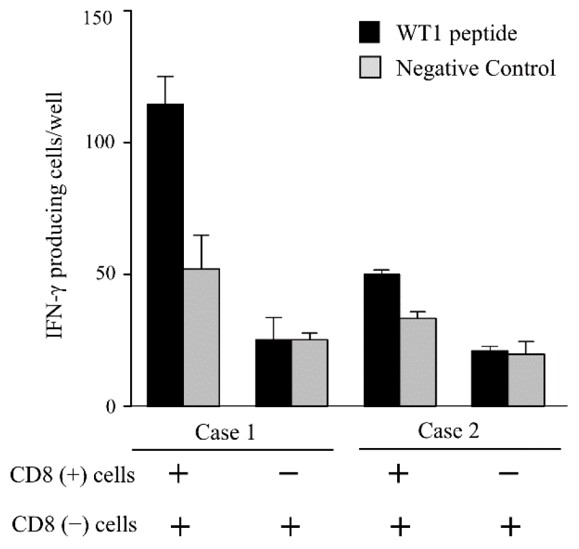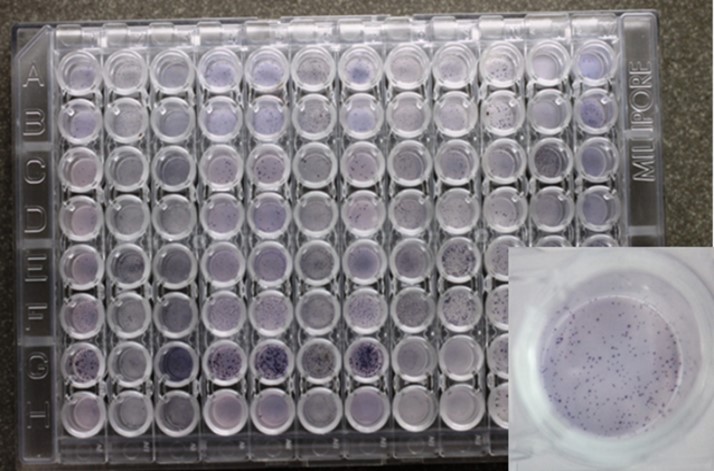The Enzyme-Linked Immunosorbent (ELISpot) assay has proven to be among the most useful means available for monitoring cell-mediated immunity and has found clinical applications in the diagnosis of tuberculosis and the monitoring of graft tolerance or rejection in transplant patients. Methods based on ELISpot have been developed in Creative Biolabs and we offer a wide range of ELISA kits for specific detection of disease-related proteins. Our professional team is optimized to help you with high-quality and cost-effective testing service to make your project a success.
The ELISpot method was developed for the detection of antigen-specific antibody-secreting cells in a B cell ELISpot assay, a modification of the conventional sandwich ELISA immunoassay. The ELISpot assay has been widely used for monitoring cellular immune responses in humans and other animals and has been clinically applied to the diagnosis of tuberculosis and to monitor graft tolerance or rejection in transplant patients. Since then, the ELISpot assay has been widely used to identify and count cytokine-producing cells at the single cell level, but it is still used to detect ASC. ELISpot technology has proven to be one of the most useful means for monitoring cell-mediated immunity because of its sensitive and accurate detection of rare antigen-specific T cells (or B cells) and the ability to visualize single positive cells within a population of peripheral blood mononuclear cells (PBMCs).
 Fig.1 Illustration of the ELISpot assay.4
Fig.1 Illustration of the ELISpot assay.4
Creative Biolabs has been devoted for the development of highly sensitive, more flexible, quantitative, and easy-to-use enzyme-linked immunosorbent spot (ELISpot) based Kits. Such method has several advantages, including:
Cytokine Bead Arrays (CBA) and conventional ELISA assays can provide extremely useful information in certain contexts but lack the sensitivity and accuracy of ELISPOT for the detection and enumeration of rare antigen-specific cells. Creative Biolabs is a world leader in the development of ELISA based kits and now offers ELISpot based kits for specific detection of disease-related proteins. If you are interested in our ELISA kits development, please feel free to contact us for more details.
1. Enzyme-Linked Immunosorbent Spot Assay for the Detection of Specific T Cells
 Fig.2 ELISpot assay of two representative cases of CD8+ T cells isolated from PBMCs.1,3
Fig.2 ELISpot assay of two representative cases of CD8+ T cells isolated from PBMCs.1,3
In this work, researchers evaluated Wilms' tumor 1 antigen-specific cytotoxic T lymphocytes (WT1-CTLs) using the ELISpot assay and compared it with MHC tetramer analysis for the first time as a validation method in DC-based cancer immunotherapy. The ELISpot assay, conducted on peripheral blood mononuclear cells, demonstrated consistent reproducibility, daily reliability, and a linear response. WT1-specific immune responses were observed in 73.9% of patients who received DC vaccinations. The correlation analysis showed ELISpot assay had a very strong correlation (Spearman`s ρ, p =0.82) with WT1 tetramer analysis. These results confirm that the ELISpot assay is a reliable and validated tool for monitoring immune responses in patients undergoing DC vaccination targeting WT1.
2. Enzyme-Linked Immunosorbent Spot Assay-Based Evaluation of Cytokines
 Fig.3 Representative image of ELISpot plates.2,3
Fig.3 Representative image of ELISpot plates.2,3
The goal of this research was to use the ELISpot assay to measure PBMCs secreting IL-10, TNF-α, IL-1β, and IL-17A cytokines in early and established Rheumatoid arthritis (RA) patients and healthy controls. The ELISpot assessed cytokine expression in freshly isolated PBMCs from whole blood to show that IL-17A-secreting PBMCs were markedly increased in early RA patients. The study demonstrates that the ELISpot assay is a reliable tool for evaluating cytokine secretion in immune responses, as it can measure in-vitro cytokine secretion by PBMCs, quantifying the number of cytokine-producing cells and detect even a single cell that secretes the cytokine of interest among millions. This method provides valuable insights into cytokine profiles and their association with RA disease activity.
References
For Research Use Only.
